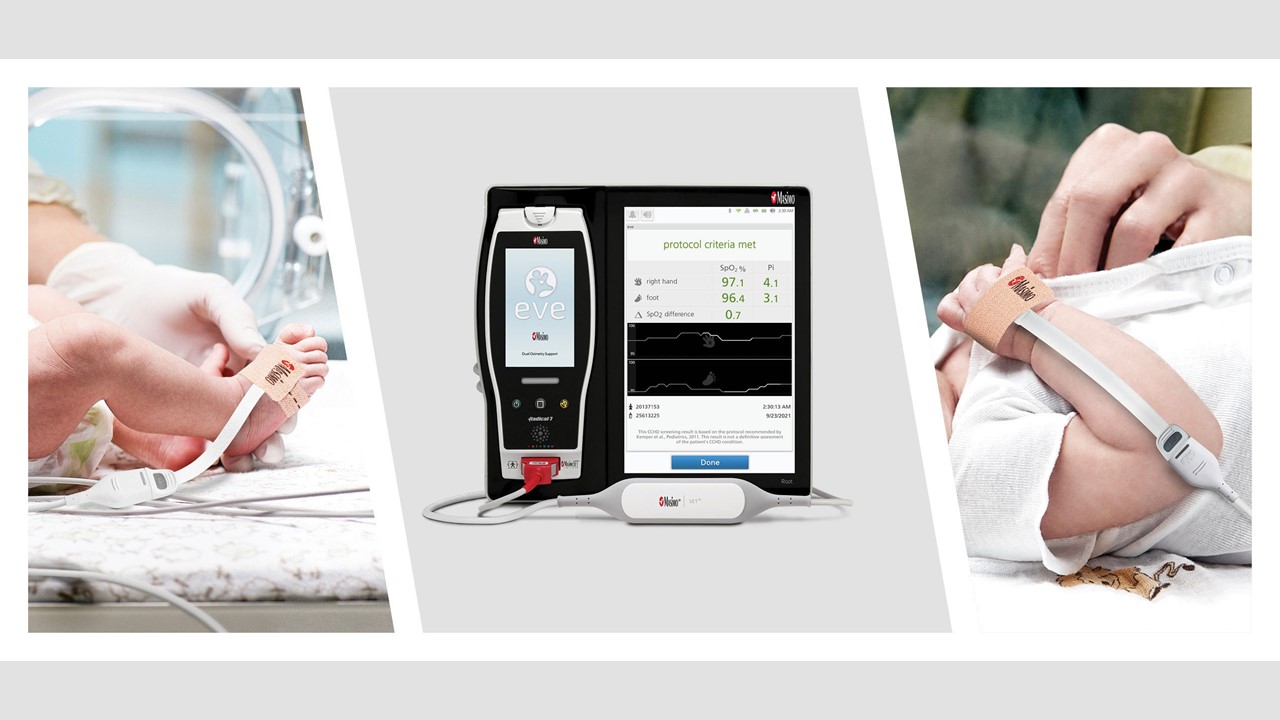Masimo announced Dual SET Pulse Oximetry for Root, a patient monitoring and connectivity hub. The first application of Dual SET Oximetry is a significant advancement to Masimo SET-guided critical congenital heart disease (CCHD) screening, with the CE marking and European launch of the Masimo SET MOC-9 module and the addition of the Eve CCHD Newborn Screening Application for Root. Together, this combined solution enhances the automation of newborn screenings using Dual SET Oximetry: two simultaneous measurements of oxygen saturation (SpO2) at pre- and post-ductal sites by the intuitive Eve application, customized to align with a hospital’s CCHD screening protocol.

CCHD affects approximately 2.5 to 3 newborns per 1000 live births1 and requires intervention soon after birth to prevent significant morbidity or mortality; later detection in infants also increases the risk of brain damage.2 Traditionally, newborns were observed for evidence of CCHD by physical assessment and monitoring for common symptoms, but studies have shown that physical assessment of newborns alone can be unreliable and may fail to detect some infants with CCHD before discharge.3-5 Adding screening with pulse oximetry can help clinicians identify CCHD before an infant becomes symptomatic.6 Clinically proven Masimo SET Measure-through Motion and Low Perfusion pulse oximetry has been shown in more than 10 CCHD screening studies – representing over 300,000 babies – to increase the effectiveness of screening newborns for CCHD.1,7-16 For example, in a study of almost 40,000 infants, CCHD screening sensitivity increased from 63% with physical exam alone to 83% with physical exam and SET.1 In another study of more than 120,000 infants – the largest CCHD screening study to date – combined use of clinical assessment and SET increased screening sensitivity from 77% to 93%.7 Evidence from CCHD studies using SET has even been used to help establish CCHD screening guidelines used around the world.17
Powered by Masimo SET pulse oximetry, the Eve CCHD Newborn Screening Application is designed to simplify the CCHD screening process by providing step-by-step visual instructions, animations, and a detailed, easy-to-interpret display of screening results – standardizing and enhancing clinical workflows, improving consistency in screening practices among clinicians, and reducing the possibility of calculation errors. Eve also allows clinicians to incorporate perfusion index into screening, which has been shown to increase sensitivity to the detection of CCHD.18-19
Already available for Radical-7 and Rad-97 Pulse CO-Oximeters, Eve is particularly well suited for display on Root’s large, high-resolution screen. With its built-in barcode scanner, Root can automatically associate patients with their screening results, and with its integration into the Masimo Hospital Automation platform, Root automates the transfer of those results to electronic medical records (EMRs) – eliminating the need for manual charting.
Now, with the addition of the new Masimo SET MOC-9 module for Root – made possible by another key differentiator of the hub, its advanced, flexible connectivity capabilities – CCHD screening guided by Eve is even more streamlined and efficient: one pulse oximetry sensor can be connected to Root via Radical-7, and a second via the MOC-9 module, allowing for the pre- and post-ductal SpO2 readings needed for screening to be taken simultaneously rather than sequentially, with results conveniently displayed on one screen. This Dual SET Oximetry technique streamlines the CCHD screening process, improving clinical workflows.
Gerard R. Martin, MD, C.R. Beyda Professor of Cardiology at Children’s National Hospital, said, “As an advocate for congenital heart disease efforts nationally and internationally, I believe Masimo SET pulse oximetry is an excellent tool for pulse oximetry CCHD screening. Having access to accurate simultaneous pre-ductal and post-ductal measurements helps simplify the process of screening and allows for rapid recognition of discrepancies, ultimately improving newborn care.”
Root is a powerful, expandable hub that integrates an array of technologies, devices, and systems to provide centralized, multimodal monitoring and connectivity solutions. Root’s plug-and-play expansion capabilities allow clinicians to simultaneously monitor with numerous measurements in addition to dual oximetry Masimo SET, such as advanced rainbow Pulse CO-Oximetry measurements, O3 regional oximetry, and SedLine brain function monitoring, for expanded visibility of patient status. Using Root in combination with the Hospital Automation platform, monitoring data from all connected devices can be automatically charted in EMRs.
Augusto Sola, MD, Vice President of Medical Affairs at Masimo, commented, “As a neonatologist who has worked nationally and internationally in the early diagnosis and treatment of hypoxemic and hyperoxemic conditions that affect neonates in order to improve neonatal survival and quality of life for these fragile infants, I know that Masimo SET measure-through motion technology’s accuracy and reliability have not only enabled CCHD screening with pulse oximetry, but have helped dramatically reduce retinopathy of prematurity (ROP).20 SET provides reliable, high-quality monitoring to prevent serious long-term morbidities and is now the standard of care for CCHD newborn screenings and ROP. With the availability of the SET MOC-9 Module, clinicians can now obtain simultaneous, dual oximetry pre- and post- ductal measurements, using one display, and increase efficiency of CCHD newborn screenings with Root. Furthermore, the Eve application on Root is automated and therefore simplifies and systematizes the screening process. Millions of newborn babies and their families throughout the world will be greatly benefited by this unique solution.”
Eve and the SET module have not obtained FDA clearance and are not available in the United States.
About Masimo
Masimo is a global medical technology company that develops and produces a wide array of industry-leading monitoring technologies, including innovative measurements, sensors, patient monitors, and automation and connectivity solutions. Our mission is to improve patient outcomes, reduce the cost of care, and take noninvasive monitoring to new sites and applications. Masimo SET® Measure-through Motion and Low Perfusion™ pulse oximetry, introduced in 1995, has been shown in over 100 independent and objective studies to outperform other pulse oximetry technologies.21 Masimo SET® has also been shown to help clinicians reduce severe retinopathy of prematurity in neonates,20 improve CCHD screening in newborns,1 and, when used for continuous monitoring with Masimo Patient SafetyNet™ in post-surgical wards, reduce rapid response team activations, ICU transfers, and costs.22-24 Masimo SET® is estimated to be used on more than 200 million patients in leading hospitals and other healthcare settings around the world,25 and is the primary pulse oximetry at 9 of the top 10 hospitals as ranked in the 2021-22 U.S. News and World Report Best Hospitals Honor Roll.26 Masimo continues to refine SET® and in 2018, announced that SpO2 accuracy on RD SET® sensors during conditions of motion has been significantly improved, providing clinicians with even greater confidence that the SpO2 values they rely on accurately reflect a patient’s physiological status. In 2005, Masimo introduced rainbow® Pulse CO-Oximetry technology, allowing noninvasive and continuous monitoring of blood constituents that previously could only be measured invasively, including total hemoglobin (SpHb®), oxygen content (SpOC™), carboxyhemoglobin (SpCO®), methemoglobin (SpMet®), Pleth Variability Index (PVi®), RPVi™ (rainbow® PVi), and Oxygen Reserve Index (ORi™). In 2013, Masimo introduced the Root® Patient Monitoring and Connectivity Platform, built from the ground up to be as flexible and expandable as possible to facilitate the addition of other Masimo and third-party monitoring technologies; key Masimo additions include Next Generation SedLine® Brain Function Monitoring, O3® Regional Oximetry, and ISA™ Capnography with NomoLine® sampling lines. Masimo’s family of continuous and spot-check monitoring Pulse CO-Oximeters® includes devices designed for use in a variety of clinical and non-clinical scenarios, including tetherless, wearable technology, such as Radius-7® and Radius PPG™, portable devices like Rad-67®, fingertip pulse oximeters like MightySat® Rx, and devices available for use both in the hospital and at home, such as Rad-97®. Masimo hospital automation and connectivity solutions are centered around the Masimo Hospital Automation™ platform, and include Iris® Gateway, iSirona™, Patient SafetyNet, Replica™, Halo ION™, UniView®, UniView :60™, and Masimo SafetyNet™. Additional information about Masimo and its products may be found at www.masimo.com. Published clinical studies on Masimo products can be found at www.masimo.com/evidence/featured-studies/feature/.
ORi and RPVi have not received FDA 510(k) clearance and are not available for sale in the United States. The use of the trademark Patient SafetyNet is under license from University HealthSystem Consortium.
References
- de-Wahl Granelli A et al. Impact of pulse oximetry screening on the detection of duct dependent congenital heart disease: a Swedish prospective screening study in 39,821 newborns. BMJ. 2009;Jan 8;338.
- Taenzer AH et al. Impact of Pulse Oximetry Surveillance on Rescue Events and Intensive Care Unit Transfers: A Before-And-After Concurrence Study. Anesthesiology. 2010; 112(2):282-287.
- Ewer AK et al. NIHR Health Technology Assessment Programme: Executive Summaries.
- de Wahl Granelli A et al. BMJ. 2009;Jan 8;
- Zhao et al. Lancet. 2014 Aug 30;384(9945):747 54.
- Ewer AK, et al. Lancet Child Adolesc Health. 2017;1(2):88 90.
- Zhao et al. Lancet. 2014;384(9945):747-54.
- Gunaratne CR et al. Sri Lanka J Child Health. 2021;50(1):04-11.
- Slitine N et al. Int J Neonatal Screen. 2020;6(53).
- Ewer AK et al. Lancet. 2011;378(9793):785-94.
- de-Wahl Granelli A et al. Acta Paediatr. 2007;96(10):1455-9.
- Meberg A et al. J Pediatr. 2008;152:761-5.
- Schena F et al. J Pediatr. 2017;183:74-79.
- Hamilçıkan S, Can E. J Perinat Med. 2018;46(2):203-207.
- Jawin V et al. PLoS One. 2015;10(9):e0137580.
- Gopalakrishnan S et al. Med J Armed Forces India. 2021;77(2):214-219
- Kemper et al. Strategies for implementing screening for critical congenital heart disease. Pediatrics. 2011 Nov;128(5):e1259-67. doi: 10.1542/peds.2011-1317.
- Siefkes H, et al. Am J Perinatol . 2020; 37(2):158 165.
- Uygur O et al. Pediatr Neonatol . 2019;60(1):68 73.
- Castillo A et al. Prevention of Retinopathy of Prematurity in Preterm Infants through Changes in Clinical Practice and SpO2 Technology. Acta Paediatr. 2011 Feb;100(2):188-92.
- Published clinical studies on pulse oximetry and the benefits of Masimo SET® can be found on our website at http://www.masimo.com. Comparative studies include independent and objective studies which are comprised of abstracts presented at scientific meetings and peer-reviewed journal articles.
- Taenzer A et al. Postoperative Monitoring – The Dartmouth Experience. Anesthesia Patient Safety Foundation Newsletter. Spring-Summer 2012.
- McGrath S et al. Surveillance Monitoring Management for General Care Units: Strategy, Design, and Implementation. The Joint Commission Journal on Quality and Patient Safety. 2016 Jul;42(7):293-302.
- McGrath S et al. Inpatient Respiratory Arrest Associated With Sedative and Analgesic Medications: Impact of Continuous Monitoring on Patient Mortality and Severe Morbidity. J Patient Saf. 2020 14 Mar. DOI: 10.1097/PTS.0000000000000696.
- Estimate: Masimo data on file.
- http://health.usnews.com/health-care/best-hospitals/articles/best-hospitals-honor-roll-and-overview.












